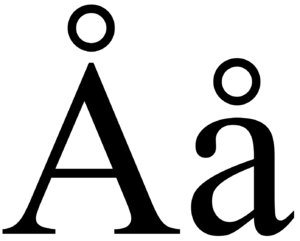Å facts for kids
The letter Å (small å) is a special letter you'll find in languages like Danish, Norwegian, Swedish, and Finnish. It looks like the letter A but has a small ring above it. This unique letter actually comes from an old vowel sound, 'Á', used in the Old Norse language long ago.
Contents
Where is Å Used?
The letter Å is an important part of the alphabets in several Nordic countries. It helps speakers of these languages make specific sounds that are different from a regular 'A'.
Nordic Languages
- Danish and Norwegian: In these languages, Å is the last letter of the alphabet. It represents a deep 'o' sound, similar to the 'oa' in "boat" or 'aw' in "saw".
- Swedish: In Swedish, Å is also near the end of the alphabet. It makes a sound like the 'o' in "go" or "home".
- Finnish: While Finnish uses Å, it's mostly found in names or words borrowed from Swedish, as Finnish is closely related to Swedish.
How Å Was Formed
The letter Å developed from the Old Norse vowel 'Á'. Over time, the way people wrote and pronounced this sound changed. The ring above the 'A' was originally a small 'a' written above the main letter, showing that it was a longer or different 'A' sound. Eventually, this small 'a' turned into the ring we see today.
What Does Å Mean in Science?
Besides being a letter in some alphabets, Å also has a special meaning in science.
The Angstrom Unit
- In science, Å is used as a short form for angstrom.
- An angstrom is a tiny unit of measurement. It's used to measure extremely small things, like the size of atoms or the wavelength of light.
- One angstrom is equal to 0.0000000001 meters, which is incredibly small!
- Scientists use Å to make it easier to talk about these tiny measurements without using many zeros.
Images for kids
See Also
 In Spanish: Å (letra) para niños
In Spanish: Å (letra) para niños



